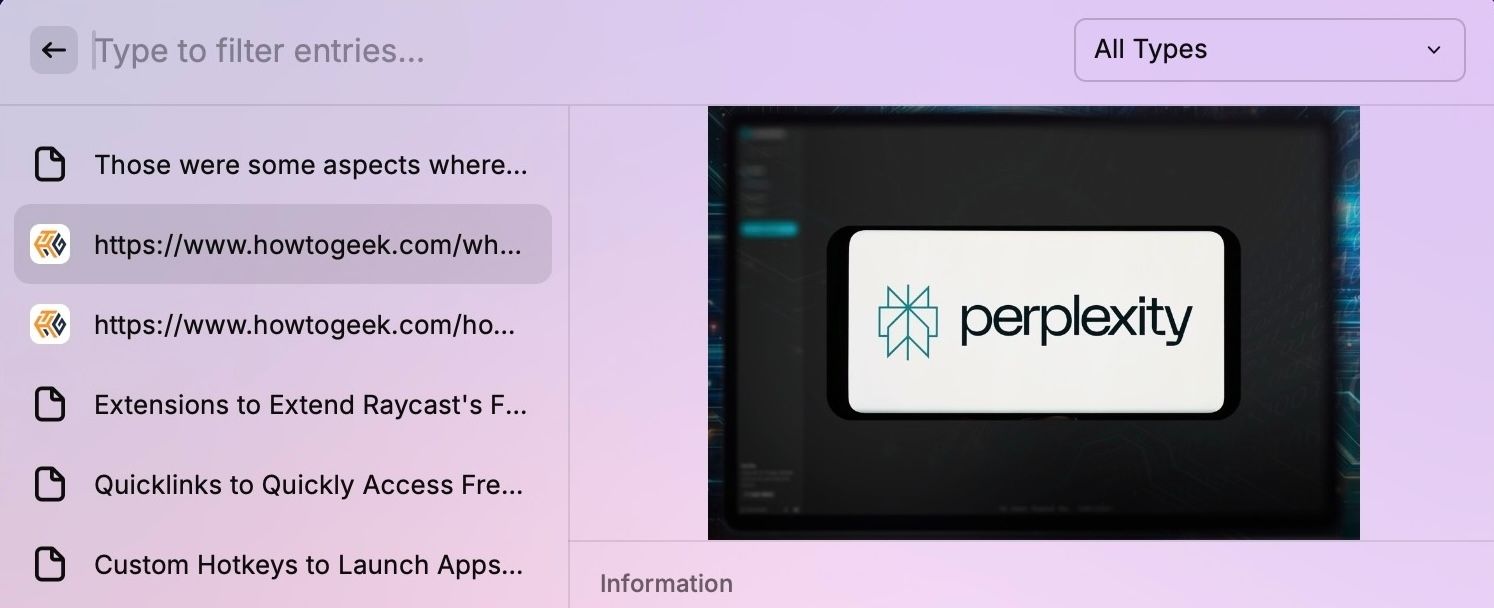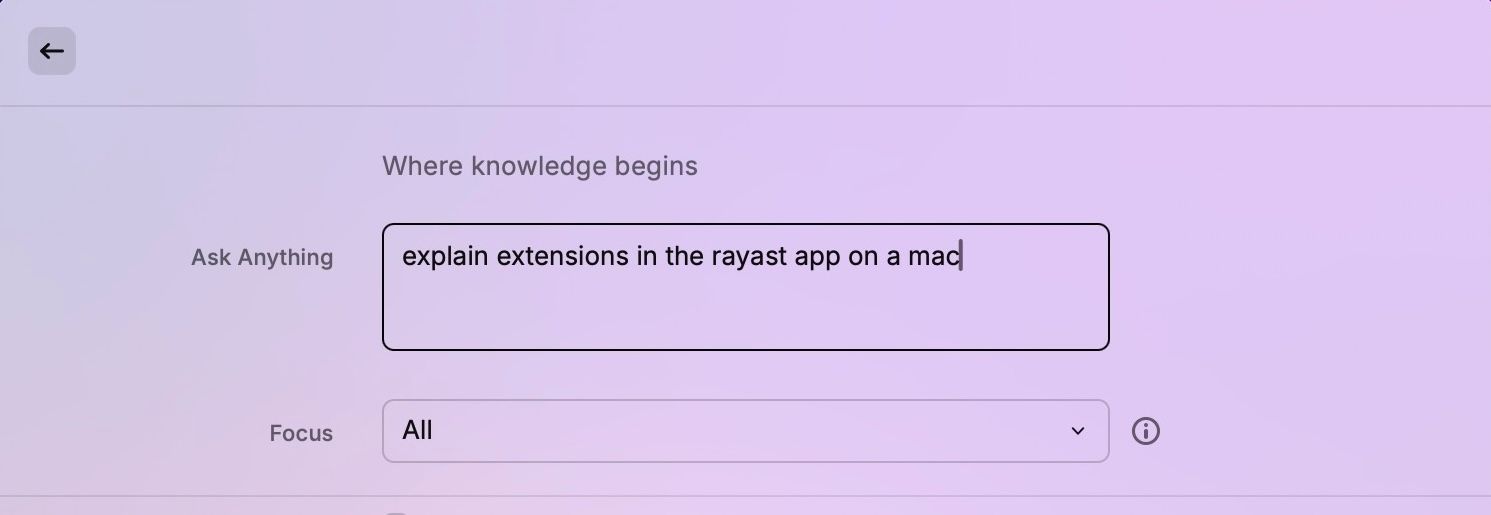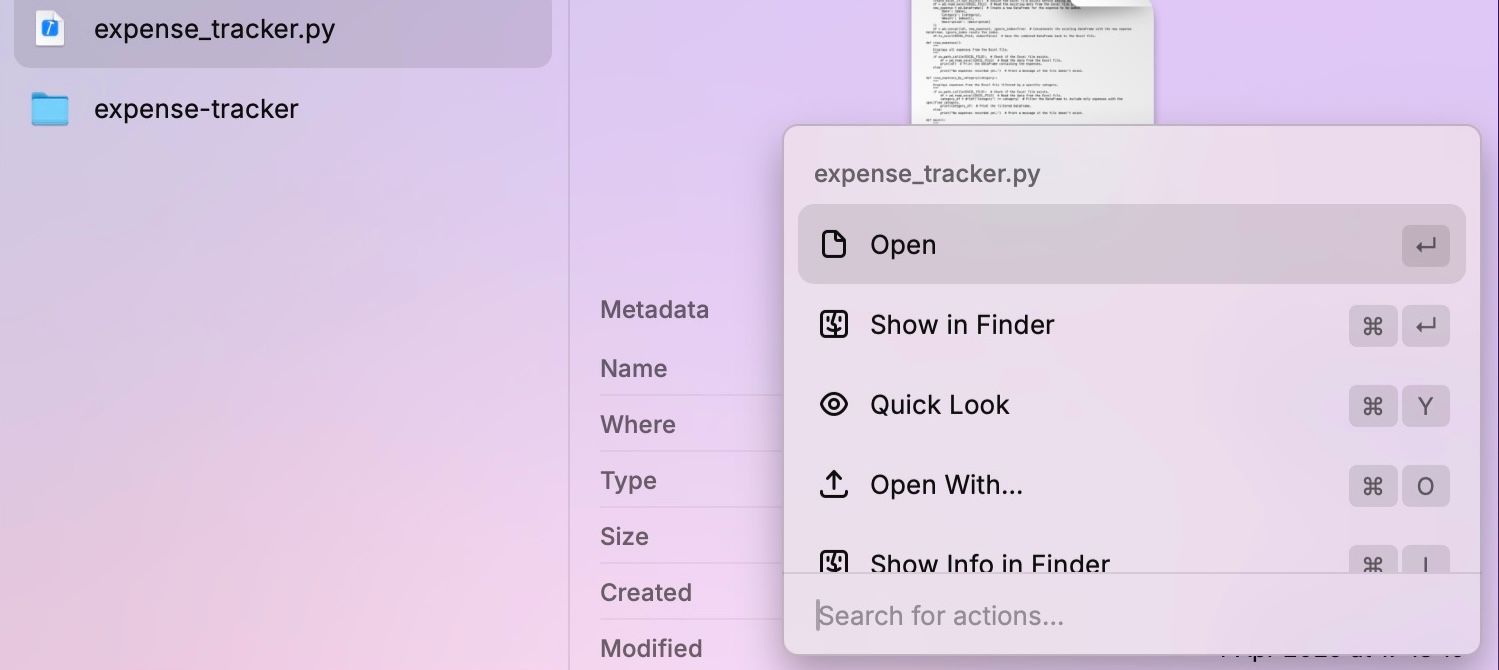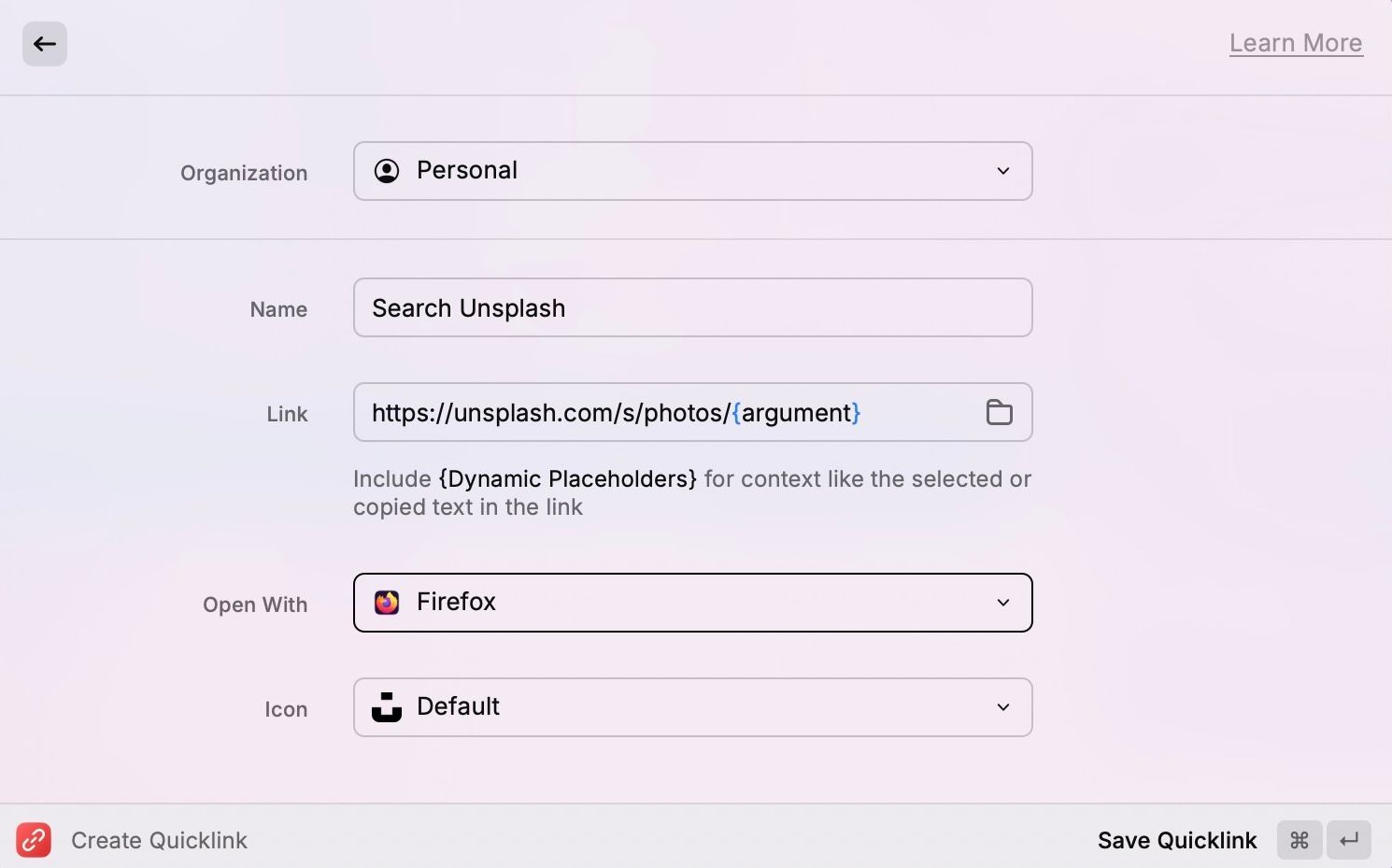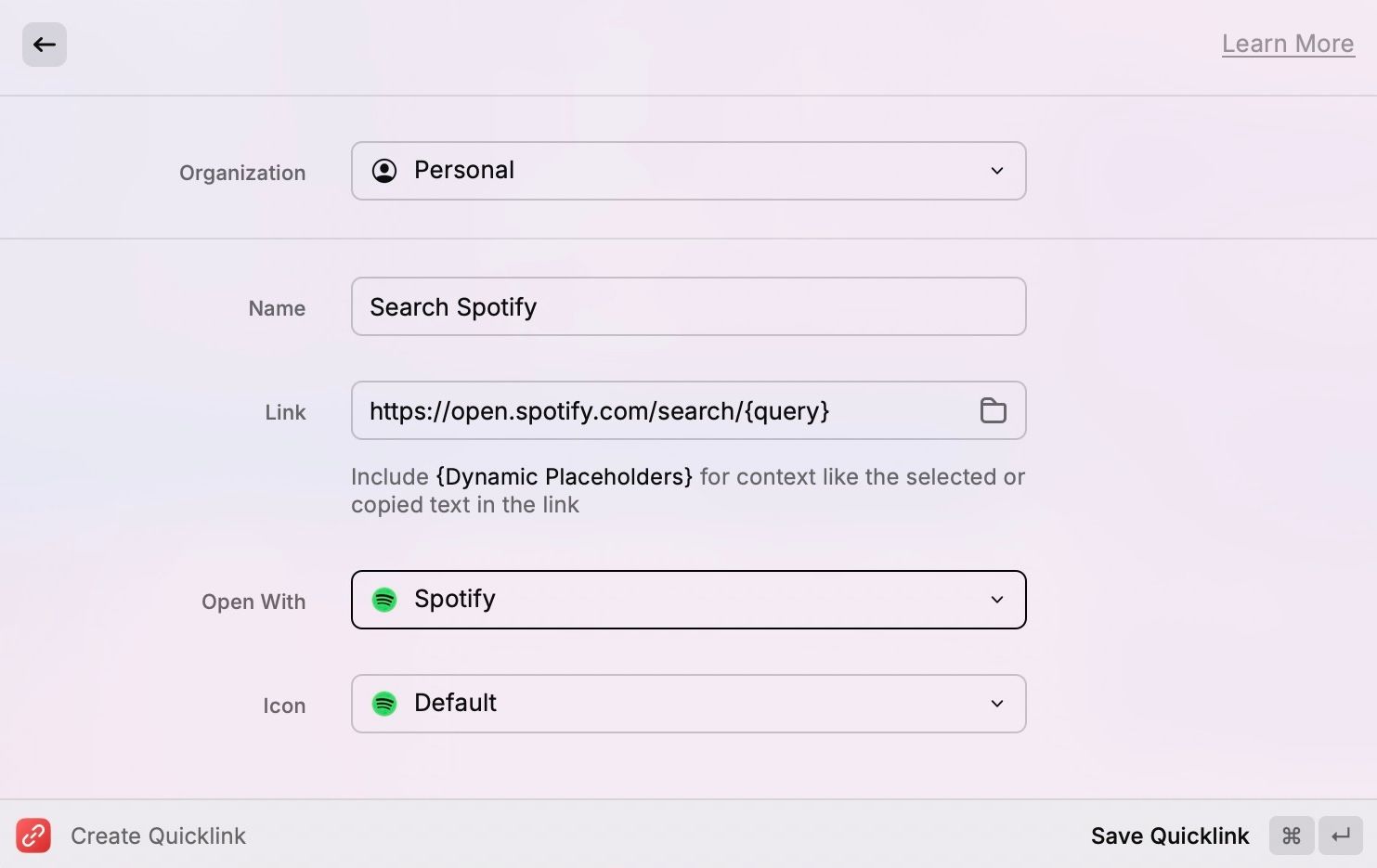Spotlight can help you accomplish a lot on your Mac, but it isn’t perfect. Apple’s combined search tool and launcher lacks many advanced features that alternatives, such as Raycast, offer.
These range from controlling third-party apps to making use of online services and even AI tools. Here are seven Raycast features that’ll make you want to ditch Spotlight on your Mac.
1
Clipboard History to View Everything You Copy
macOS doesn’t natively support clipboard history. Hence, it can only store the most recent item you copy on your Mac. This is a huge limitation if you copy-paste stuff frequently and requires you to use third-party clipboard managers to access your Mac’s clipboard history.
However, with Raycast installed on your Mac, you don’t need such an app. Raycast automatically records whatever you copy on your Mac to the clipboard history, dating as far back as three months on the free version. You can then access your copied items anytime from the Raycast search.
To do so, bring up the search, type clipboard history, and hit Return. Alternatively, you can set up a hotkey to access Clipboard History quickly. In the search window, press the Command+, shortcut to bring up its preferences. Go to the “Extensions” tab and expand the “Clipboard History” action. Finally, click the “Record Hotkey” button next to the “Clipboard History” action and assign it a keyboard shortcut.
You’ll now see all the entries in your clipboard history. Scroll through the list to find what you’re looking for. Or type it in the search field at the top. To narrow down the results, click the drop-down button in the upper-right corner and choose a type that suits the kind of item you’re looking for.
Once you find the item, select it and press the Command+Return shortcut to copy it. Alternatively, press the Return key, and Raycast will paste the item into the app in focus.
Raycast lets you disable Clipboard History for particular apps on your Mac to exclude sensitive information such as passwords or personal notes. Access the Clipboard History options in Raycast settings and choose the apps you want to exclude.
2
Quickly Perform System Tasks
Another standout Raycast feature is the ability to perform system tasks right from the Raycast search. So, rather than opening apps and navigating multiple menus, you can carry out these tasks with a few key taps, which saves you both the time and effort you’d otherwise put into performing the same tasks manually.
A system task could be anything from setting the volume to your desired percentage or toggling system appearance to ejecting disks, putting your Mac to sleep, or emptying the Trash, among others. Raycast supports multiple system actions. You’ll discover them as you use the Raycast search more and more. You can always look up an action to see if Raycast supports it.
To find and perform a system action via Raycast, access the search and describe the action. For example, say you want to empty the Trash on your Mac. Simply type “Empty Trash” and hit Return. When prompted, click the “Empty Trash” button.
You can further simplify access to system tasks you use more frequently by assigning them aliases or hotkeys.
Raycast gives you instant access to some of the popular AI chatbots using extensions. So, if you use Gemini, ChatGPT, or Perplexity AI for your everyday tasks, you can integrate them into the Raycast search. Doing so will save you the need to open their native apps or visit their websites in a browser every time you want to use these tools.
Integrating your favorite AI chatbot into Raycast is easy. Head to Raycast preferences using the Command+, shortcut. Go to the Extensions tab and click the “+” button in the upper-right corner or press Command+N. Select “Install from Store” from the menu. Now, look for your favorite chatbot in the search field at the top. Double-click on it to view more details and press the Return key to install the extension.
Once installed, summon the AI chatbot by typing its name, like Perplexity, or using the hotkey if you’ve set one up. Then, type in your query and hit Return.
Depending on the chatbot you’re using, it may return the result in the same window inside the Raycast search or open it in a tab in your Mac’s default browser.
4
Quickly Locate Files and Perform Quick Operations on Them
Raycast is exceptionally fast at helping you find files on your Mac and quickly perform actions on them without opening specific apps. It relies on macOS’ Spotlight indexing system but employs fuzzy search to give you more flexibility when looking up things in the search and, in turn, improve your chances of finding what you want. You can adjust the sensitivity to control the number of matching results Raycast returns.
Looking up files in Raycast search is super simple. Simply access it, type “Search Files,” and hit Return. You can also assign a hotkey to access it even more quickly. Then, enter your search term, and you’ll see a bunch of results with all the metadata in the right sidebar.
Once you’ve found the file you’re looking for, select it and press the Command+K shortcut to reveal all the compatible actions you can perform on it. Press the corresponding keyboard shortcut next to the action you want to perform or select it and hit Return.
Raycast will now carry out the operation on the selected file.
5
Custom Hotkeys to Launch Apps in No Time
Although you can find and launch apps from the Raycast search—just like files and settings—Raycast offers a more efficient approach if you need to access them even more quickly. It involves setting up a hotkey—a custom keyboard shortcut—for your favorite or most-used apps.
To do this, access Raycast search. Go to the “Extensions” tab and expand the “Applications” list. Click the “Record Hotkey” button next to the app you want to assign a hotkey to and press the keyboard combination you want to use. Avoid assigning shortcuts like Command+A or Command+S to apps, as these are often reserved for system actions and can cause conflict.
With hotkeys assigned, launching apps with them is easy. Simply press the hotkey anywhere on your Mac—irrespective of the space or the app you’re in—and Raycast will open the corresponding app.
6
Quickly Access Frequently-Used Websites or Folders
Quicklinks is a nifty feature that allows you to create shortcuts for anything you need to access quickly on your Mac. Want to search for songs on Spotify or find images on Unsplash? With Quicklinks, you can do it directly from the Raycast search without opening any specific app.
Raycast comes bundled with a few Quicklinks. But you’ll want to create your own to get the most out of the feature. To do so, go to Raycast settings and head into the “Extensions” tab. Click “Quicklinks” and hit the “Find in Library” button on the right sidebar.
Now, say you want a Quicklink to search Unsplash. Type “Unsplash” in the search field and click on the matching result. Click the drop-down next to “Open With” and select your preferred browser. Raycast will use this browser to look up and show results from Unsplash. Set up a hotkey for the quicklink to enable quick access.
To use this Quicklink, access Raycast search, type “Un” or press the hotkey, and it should bring up the Quicklink. Hit the Tab key and start typing your query. Press Return when you’re done, and Raycast will take you to the Unsplash website in your specified browser with all the matching results for your query.
Alternatively, if Raycast doesn’t have a Quicklink, you can create one yourself. Let’s set one up that lets you search for songs on the Spotify app from the Raycast search. Access Quicklinks in the Raycast preferences, select it, and click the “Create New Quicklink” button on the right. Type a name for the Quicklink in the “Name” field. Let’s call it “Search Spotify.”
Next, type the following in the Link field: “https://open.spotify.com/search/{query}.” Here {query} is a dynamic placeholder, meaning Raycast will replace it with whatever search term you type when running the Quicklink. Click the drop-down next to “Open With” and select “Spotify.”
Now, whenever you want to look up an artist, song, or playlist, simply bring up the Raycast search and type its name. The Quicklink will look it up and show you the results in the Spotify app on your Mac.
7
Extensions Extend Raycast’s Functionality Even Further
While Raycast packs many advanced capabilities by default, it lets you add new functionalities using extensions. Extensions are essentially programs that add new functionality or integrate third-party services into Raycast so you can quickly access them via the Raycast search.
Raycast’s extension store is home to a host of extensions, spanning various categories from AI extensions and developer tools to applications and web tools, among others. For example, you can use the Google Translate extension to quickly translate text, ChatGPT to directly access the assistant, Video Downloader to download videos from various websites, or Shell to run shell commands directly from the search.
Finding and installing a Raycast extension is easy. Bring up Raycast search and look up “Extensions.” In the “Extensions” tab, click the “+” button in the upper-right corner or press Command+N and select “Install from Store.” Browse the list or search for an extension. Double-click it to view all its details and hit Return to begin the installation.
Once installed, you’ll find the extension in the “Extensions” tab in Raycast settings. Assign the extension a hotkey to enable quick access. You can now use this hotkey anywhere on your Mac to bring up and use the extension.
Those were some aspects where Raycast outshines macOS’ built-in Spotlight search. But it doesn’t end there. Raycast packs plenty of other features that can significantly enhance productivity on your Mac. These include a hyper key, built-in window management tools, floating notes, and text snippets and expansion, to name a few. So, install Raycast if you haven’t already, and explore the new possibilities it unlocks on your Mac.



